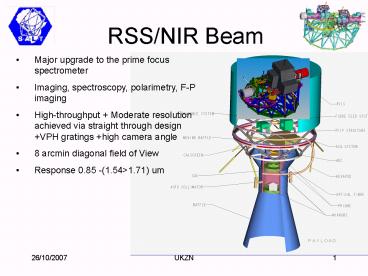RSSNIR Beam PowerPoint PPT Presentation
1 / 35
Title: RSSNIR Beam
1
RSS/NIR Beam
- Major upgrade to the prime focus spectrometer
- Imaging, spectroscopy, polarimetry, F-P imaging
- High-throughput Moderate resolution achieved
via straight through design VPH gratings high
camera angle - 8 arcmin diagonal field of View
- Response 0.85 -(1.54gt1.71) um
2
RSS/NIR Beam Project Team
PI Prof. Andy Sheinis P.S. Dr. Marsha
Wolf P.M. Bob Paulos (Ice Cube) Optical
design Prof. Harland Epps Systems
engineer Kurt Jaehnig ME Dr. Bruce
Bigelow ME Rafael Silva ME Al
Rogers Thermal Dr. Carl Cheng (Bit7) SE Dr.
Jeff Percival TBD Fabrication SAL/Madison Inte
gration TBD
3
RSS/NIR Beam Science Case
- Simultaneous Fabry-Perot NIR imaging spectroscopy
and visible spectroscopy - High throughput, medium resolution NIR
spectroscopy. - Spectropolarimetry
4
Science goals
- Cosmological studies of z gt 6 galaxies NIR
Fabry-Perot imaging of pre-determined small range
of redshift space scanning through 100-200
Angstroms between the OH lines. - NIR spectroscopy of star forming regions and
superstar clusters in the Small Magellanic Cloud. - Brown dwarfs. Combined visible FP imaging with
NIR spectroscopy to locate and confirm local BD
population, NIR excess to look for circumstellar
disks of planet-forming material. - Rapidly variable polarimetric objects
- Magnetic cataclysmic variables
- Pre-main sequence stars
- Novae, supernovae
- Gamma ray bursts (longitudinal advantage)
- Magnetic field mapping of regions of the Milky
Way.
5
RSS/NIR Beam Highlights
77K
-20 to -80C
6
Conceptual design of small thermal enclosure
7
(No Transcript)
8
(No Transcript)
9
New IR Camera
10
RSS/NIR Beam detector
- 8 arc-minute circumscribed field
- 6 pixels/ arcsecond
- Hawaii 2RG
- 2048 x 2048
- 18 um pixels
- Talking to U of Florida to provide system
Hawaii 2RG
4 Radius
11
RSS/NIR Beam Instrument Noise/Performance
Estimate
- H-band limiting-magnitude model
- cold filter cutoff of 1.7 µm.
- integration widow of 1 x 1,
- SNR requirement of 3,
- integration time of 1 hour,
- ambient temperature of -20C
- cryogenic temperature of 77K,
- spectral resolution of 4000,
12
RSS/NIR Beam Instrument Noise/Performance
Estimate
- H-band limiting-magnitude model
- cold filter cutoff of 1.7 µm.
- integration widow of 1 x 1,
- SNR requirement of 3,
- integration time of 1 hour,
- ambient temperature of -20C
- cryogenic temperature of 77K,
- spectral resolution of 4000,
13
Instrument Noise/Performance Estimate-NIR Cut-off
- 1.54 um no Narcissus mirrors, no additional
cooling beyond the Dewar and pre-Dewar hosing the
camera and detector. - 1.62 um Adding a gold-coated slit, with
effective emissivity of 0.1 and gold coating the
moving baffle, blocking 50 of the warm
observatory radiation increase the red coverage
to 1.62 um. - 1.66 um Reducing the ambient instrument
temperature to -10C. Minimum achievable
temperature will be determined by optical design
constraints and opto-mechanical issues. - 1.71 um reducing the ambient temperature down to
the opto-mechanical design limit of -20C,
reducing the slit emissivity to .03 and
introducing an internal cold-baffle at this same
temperature to block ½ of the unwanted
grating-coupled radiation.
14
Cost Estimate
2.6M
15
Cost Estimate
3.4M
16
New Initiative 1 Adaptive Optics
17
Kolmogorov turbulence in a nutshell
- Big whorls have little whorls,
- Which feed on their velocity
- Little whorls have smaller whorls,
- And so on unto viscosity.
L. F. Richardson (1881-1953)
18
SALT AO Working Group
- UW Andy Sheinis, Marsha Wolf, Matt Bershady,
Jeff Percival, Kurt Jaehnig - SAAO David Buckley, Steve Crawford
- AMNH Ben Oppenheimer, Anand Sivaramakrishnan,
Mike Shara - UH Mark Chun
- Steward Matt Kenworthy
- Durham Richard Wilson
19
Why is adaptive optics needed?
- Image motion
- Image blurring
- Scintillation
- Dome seeing
- Telescope static and dynamic errors
Even the largest ground-based astronomical
telescopes have no better resolution than an 8"
telescope!
20
Turbulence arises in several places
stratosphere
10-12 km
wind flow around dome
boundary layer
Heat sources w/in dome
21
Boundary layer profiles from SODARs (acoustic
sounders)
Turbulence profile
22
SALT AO Working Group Measurement
- MASS-DIMM exists at SAAO, Steve Crawford and
David Buckley are coordinating - SLODAR will get on loan from Richard Wilson at
Durham - Delivery to SALT in March 2008
- Remain at the mountain for 1-year to develop
statistics
23
Images of a bright star, Arcturus
? 1 arc sec
? 0.1 arc sec l / D
Long exposure image
Short exposure image
Image with adaptive optics
Energy density is NOT increased once the object
is resolved!
24
Canada France Hawaii Telescope
Unresolved objects get tremendous energy density
increase
Fifteen minute integration time 0.19 arc sec
resolution
25
Neptune in infra-red light (1.65 microns)
With Keck adaptive optics
Without adaptive optics
2.3 arc sec
May 24, 1999
June 27, 1999
26
Adaptive optics 101
DM fitting error
Not shown tip-tilt error
Non-common path errors
Phase lag, noise propagation
Measurement error
27
SALT AO Working GroupAO Concept
- 91 Active Tip/tilt correctors
- Hardy predicts 89 energy in tip/tilt Zernike
terms under Optimum circumstances D/r04 - Designed around vis/nir fiber instrument
- Senses reflected light at the fiber or
- Traditional WFS on NGS
- Slow mode(0.1 Hz) to correct thermal, flexure
- Fast Mode(100Hz) to correct seeing.
Matt Kenworthy U of A
28
SALT AO Working Group
29
SALT AO Working Group
30
New Initiative 2 Diffractive Spectroscopy
31
Spatial Heterodyne Spectroscopy (SHS)
- Resolution independent of aperture size !
- Developed at UW (Roesler, Harlander, Mierkiewicz
in Physics, Reynolds in Astro) - Flown on space shuttle
- Emission-line gas
- Diffuse objects
- Distant galaxies
R26,000 over 1.6 x 3.2 degrees
32
Cant Beat Optical Invariant
dA
D?
SNR SQRT(E)
33
(No Transcript)
34
(No Transcript)
35
Summary
- RSS/NIR 2011
- AO Simple yet novel corrector concept
- New technologies to take full advantage of SALT
strengths

